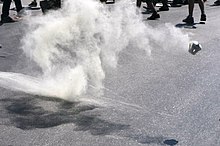
Back Traangas Afrikaans غاز مسيل للدموع Arabic Gas llacrimóxeno AST Gözyaşardıcı qaz Azerbaijani Gas yéh mata BAN Сълзотворен газ Bulgarian কাঁদানে গ্যাস Bengali/Bangla Gas lacrimogen Catalan گازی فرمێسکڕێژ CKB Slzný plyn Czech


Tear gas, also known as a lachrymatory agent or lachrymator (from Latin lacrima 'tear'), sometimes colloquially known as "mace" after the early commercial self-defense spray, is a chemical weapon that stimulates the nerves of the lacrimal gland in the eye to produce tears. In addition, it can cause severe eye and respiratory pain, skin irritation, bleeding, and blindness. Common lachrymators both currently and formerly used as tear gas include pepper spray (OC gas), PAVA spray (nonivamide), CS gas, CR gas, CN gas (phenacyl chloride), bromoacetone, xylyl bromide, chloropicrin (PS gas) and Mace (a branded mixture).
While lachrymatory agents are commonly deployed for riot control by law enforcement and military personnel, its use in warfare is prohibited by various international treaties.[NB 1] During World War I, increasingly toxic and deadly lachrymatory agents were used.
The short and long-term effects of tear gas are not well studied. The published peer-reviewed literature consists of lower quality evidence that do not establish causality.[1] Exposure to tear gas agents may produce numerous short-term and long-term health effects, including development of respiratory illnesses, severe eye injuries and diseases (such as traumatic optic neuropathy, keratitis, glaucoma, and cataracts), dermatitis, damage of cardiovascular and gastrointestinal systems, and death, especially in cases with exposure to high concentrations of tear gas or application of the tear gases in enclosed spaces.[2]
Cite error: There are <ref group=NB> tags on this page, but the references will not show without a {{reflist|group=NB}} template (see the help page).